 Successful 2015 ABA Maybank
Successful 2015 ABA Maybank
Short Term Visiting Program in Kuala Lumpur
Malayan Banking Berhad (Maybank) successfully conducted the two day ABA Short Term Visiting Program in its headquarters in Kuala Lumpur on November 2-3, 2015. The program, attended by 24 bank delegates from 13 banks originating from 10 countries featured 9 different banking subjects, 4 on the first day and 5 on the second day, each subject featuring a Division Head of Maybank as speakers.
The first day
The first session on “Maybank international’s journey, mission and aspirations” was presented by Lim Siow Yee, Head of STBE International. Originally based in Singapore, Ms. Lim flew from Singapore to share with the delegates her long and intimate of knowledge Maybank’s international expansion and operations.
Ms. Lim noted that among the many international issues experienced by Maybank, the ASEAN market showed interesting developments, such as Cambodia leapfrogging telecommunications processes into direct mobile banking, rapidly catching up with regional players, allowing for servicing of local wealthy customers directly from Singapore, where they can expect higher quality services.
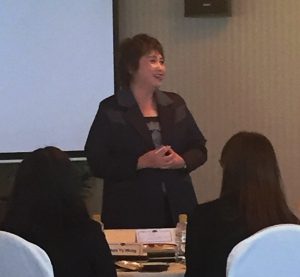 Ms. Lim also reported that Myanmar, with 23 local banks, is a country where Maybank had more than 10 years cultivating relationships with government officials and regulators. Myanmar’s long awaited Myanmar’s licensing of foreign banks in 2014 turned out beneficial to Maybank and helped complete their ASEAN’s flush. By practicing a strategy of careful cultivation of local relationships and consistent long term engagement, Maybank has managed to build a strong presence in 10 ASEAN countries, a recent operation in Papua New Guinea (40 Asian countries in total), totaling 55 thousand employees worldwide. This international expansion nowadays generates 40% of the bank’s revenues, while relying on the US and UK markets for funding its lower capital cost.
Ms. Lim also reported that Myanmar, with 23 local banks, is a country where Maybank had more than 10 years cultivating relationships with government officials and regulators. Myanmar’s long awaited Myanmar’s licensing of foreign banks in 2014 turned out beneficial to Maybank and helped complete their ASEAN’s flush. By practicing a strategy of careful cultivation of local relationships and consistent long term engagement, Maybank has managed to build a strong presence in 10 ASEAN countries, a recent operation in Papua New Guinea (40 Asian countries in total), totaling 55 thousand employees worldwide. This international expansion nowadays generates 40% of the bank’s revenues, while relying on the US and UK markets for funding its lower capital cost.
During the first session, delegates had the pleasure of an impromptu presentation of Pollie Sim, CEO of International at Maybank, who with decades of experience in the banking industry has become a true icon in the corporation. Her comments were based on practical management experiences. She recommended personal engagement with the troops, as she argued that leadership could account for 50% of the company’s success.
The second session on “Counterparty opportunities in Malaysia” was presented by Farid Khari, Deputy Head of Global Markets who skillfully proceeded to deflate myths about the large profits generated in trading. Instead, Farid Khari said that he did not expect a raise in interest rates because of the bankruptcy risk in mortgage market, credit card and related liabilities. Moreover, he did not see global market trading as a profit star in banking anymore, probably because of the competition among banks and regulation. Instead he projected growing importance in the areas of transaction banking, relending and trade financing as profit drivers in the banking future.
Besides the class time on the headquarters’ top floor, ABA delegates were taken to the trading floor operations where they observed the behind the scene actions that at the moment appeared tranquil. Though Farid Khari said it was just so few weeks earlier when international market volatility created a tense and hectic environment in the floor. The tour of delegates also went to the exercising facilities nearby where traders are encouraged to unwind job’s pressures by day’s end.
The tour was followed by a delicious banquet lunch on Maybank’s VIP top floor restaurant in an atmosphere of sincere hospitality.
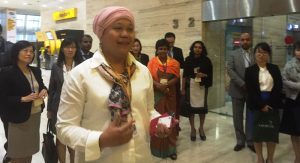 The third session started in the afternoon of the first day, when delegates proceeded to the lobby and first floor of Maybank’s headquarters, where Norazizah Hamid, Head KL in the Main Branch, together with Nor’ Azita Asis Fadzillah led all delegates on a tour of the front and back installations of the customer service area. It was a tremendous opportunity for bankers to see how Maybank managed the customer’ experience practically. Many delegates even took photos of Maybank’s office’s layout and design adorning the walls.
The third session started in the afternoon of the first day, when delegates proceeded to the lobby and first floor of Maybank’s headquarters, where Norazizah Hamid, Head KL in the Main Branch, together with Nor’ Azita Asis Fadzillah led all delegates on a tour of the front and back installations of the customer service area. It was a tremendous opportunity for bankers to see how Maybank managed the customer’ experience practically. Many delegates even took photos of Maybank’s office’s layout and design adorning the walls.
Delegates asked questions concerning the service flow among the back offices, and design of workspace to achieve efficiency. Delegates also appreciated the design of individualized service desk for average customers in the lobby that allowed for more quality interaction and better customer care.
The fourth session of the first day focused on “The Wave of Wealth Management in Asia” under the guidance of Eunice Chan Chun Hei, Head of HNW & Affluent Banking. Issues related to an emerging affluent HNW (High Networth Wealth) generation in Asia were discussed.
This session attracted avid attention of the participants because Asian economic growth, particularly in ASEAN countries, is producing a new generation of inherited wealth, where Millennials appear to prefer liquid assets. Moreover, given technological drivers in the marketplace, primarily mobile banking, professional wealth managers must quickly know the situation of clients using different platforms, be it, Facebook or any other application.
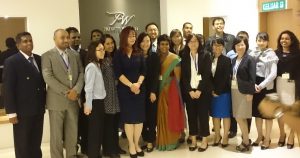 The results of a fast professional wealth-client interaction due to technological change requires data analytics, thus Maybank’ interest in surveys of market’s and clients’ needs. At the moment Maybank holds mobile banking’s 45% market share with some 110 thousand wealthy clients engaged.
The results of a fast professional wealth-client interaction due to technological change requires data analytics, thus Maybank’ interest in surveys of market’s and clients’ needs. At the moment Maybank holds mobile banking’s 45% market share with some 110 thousand wealthy clients engaged.
During the presentation, it was recommended that for a successful management of wealthy clients, the wealth management specialist should keep 3 basic attitudes permanently in mind: (1) Observance of client’s sentiment, (2) Analysis of data (market and personal), (3) Do not losing any opportunity.
Those three fundamental ingredients are the basis of good service that will allow for the successful attainment of wealth management’s objective: (1) To protect, (2) To manage, and (3) To accumulate wealth.
At the end of the session, and beyond the original schedule, the presenter and her team of assistants graciously took the ABA delegates for a tour of the complete floor exclusively designed for VIP customers. On the floor, different meetings rooms were designed for one-on-one, small and large group of VIP meetings. Many questions emerged during the whole session, such as those from Jerome O. Dobles from Philippine National Bank, who asked about practical issues such as how to handle seamlessly the handover upgrade or downgrade of high net accounts among different people within the bank.
In fact, a group of delegates, led by Nandakumar from Hatton National Bank remained much longer in the VIP facilities conferencing with Eunice and her team.
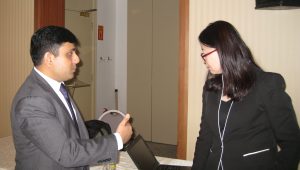
The second day
The second day, November 3rd, comprised 5 different sessions, starting with the fifth presentation on “The role of compliance and moving forward” under the guidance of Jans Lim Mei Lin, Head of Group Risk Compliance. The 80-minute presentation was animated with the active participation of delegates asking questions throughout the presentation.
As Jans Lim Mei Lin explained, the present banking environment of regulations, with compliance issues ranging from trading procedures to reduce bank’s financial risk exposure, money laundering risk up to FATCA implementation, demands close monitoring of operations at all levels. Thus the necessity to create committees at the board level that signals to all employees the new standard conditions of banks.
During the presentation, delegates were able to observe practical implementation of compliance techniques all over the organization, trying to strike a balance between compliance and efficiency. Abdullah Juma Mubarak Al Maamari from Bank of Muscat discussed compliance procedures to detect money laundering.
After her presentation, Jans Lim Mei Lin held a pre-arranged meeting with Manoj Pitadeniya (Hatton National Bank) and answered questions from Abhishek Gupta (SMBC Singapore), Nguyen Thi Phuong Dang (Vietcombank) and others.
Thereafter, the delegates enjoyed a tea break with delicious desserts, just before the second session of the day “Risk Culture” was launched.
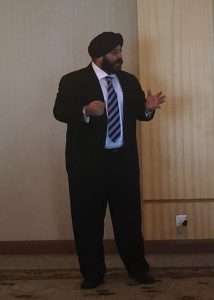 The sixth presentation under Mr. Khushwant Singh, Head of System and Analytics was a practical, detailed and humor-laced session that captivated the audience’s attention. In his opening remarks, Mr. Singh said “the risk issue is about protecting the brand” and from that tenet, risk must be evaluated.
The sixth presentation under Mr. Khushwant Singh, Head of System and Analytics was a practical, detailed and humor-laced session that captivated the audience’s attention. In his opening remarks, Mr. Singh said “the risk issue is about protecting the brand” and from that tenet, risk must be evaluated.
Since by definition, banking is about risking capital to strangers, risk must be clearly understood at every level of the organization, starting from the CEO, who signals, by his presence, that everybody must do so too, as Maybank’s CEO normally does.
Mr. Singh indicated that in Maybank, the risk culture is an issue of education. One example is a sort of “study cases without names” sessions where real risk problems within the organization are analyzed and studies are part of the collective know-how. Another program is the incentives and rewards that Maybank awards to its employees when they discover malfeasance or errors in risk managements.
Mr. Singh’s experience in implementing risk culture education at all level indicates that the workforce’s limited attention span due to heavy workload and competing interests in modern life demands innovative, easily absorbed and consistent educational techniques. Thus Maybank’s use of comic strips characters, story lines, and easily understood messages to educate its workforce.
Mr. Singh was adamant in emphasizing on the need of creating top to bottom risk culture, where every employee was aware of risk, starting from the frontline, with the first employee engaging a new customer, and within each step along the workflow.
Mr. Singh emphasized that policy stipulation is not the end of everything. Instead, risk culture policy has to be developed from a belief that is reinforced by positive attitudes resulting in a permanent behavioral change for the better. The ultimate objective is to nurture integrity in the organization where employees will do the right thing even when no one is watching them.
After Mr. Singh’s presentation, delegates enjoyed a great lunch where they commingled and shared information among the participants.
The seventh presentation in the afternoon of the second day featured a shorter but intense session on “Client experience from a transaction banking experience,” featuring Loo Eng Hook, Director of Business Initiatives and Project Execution.
With many years of experience working for Citi, Mr. Loo motivated the audience on the areas of client service and exhorted participants into exploring new technologies of digitalization to facilitate and even simplify customer’s transaction processes, thus accelerating cash flow. Moreover, Mr. Loo emphasized that sustainability and quality of service worked hand in hand, and that only through a permanent customer experience, the bank’s future is achieved.
Though lasting only some 45 minutes, Mr. Loo’s presentation produced a lot of discussions, to the point that after his presentation many delegates engaged him in a group Q&A for many more minutes.
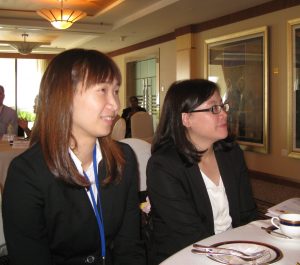 The eight presentation in the afternoon was “Working capital management for transaction banking.” The session was a real surprise for many participants because of the fast pace and insightful analysis of the presenter, Mahadir Manap, who with his candid comments elicited practical, yet quite technical questions facing many of the delegates in their respective banks. For instance, the presentation of a real life case of supply chain digitalization from rice field production to P.O.S illustrated perfectly the evolution of transaction banking nowadays.
The eight presentation in the afternoon was “Working capital management for transaction banking.” The session was a real surprise for many participants because of the fast pace and insightful analysis of the presenter, Mahadir Manap, who with his candid comments elicited practical, yet quite technical questions facing many of the delegates in their respective banks. For instance, the presentation of a real life case of supply chain digitalization from rice field production to P.O.S illustrated perfectly the evolution of transaction banking nowadays.
According to Mr. Manap’s experience, JP Morgan and Deutsche Bank are leading in this area, thus they deserve our attention. The presentation further discussed the allocation of working capital for operations and current accounts as well as its effects on long-term investments at some practical level. At this moment, many delegates raised questions asking for Mr. Manap’s opinion about their own cases.
After his allocated time, Mr. Manap remained a lot longer sharing experiences and answering questions with Ms. Dung (Vietcombank), Mr. Nandakumar (Hatton), Mr. Gupta (SMBC Singapore), Mr. Dobles (Philippine National Bank).
The ninth and last presentation of the day was made by Mr. Wong Cheong Keat, Head of Investment & Advisory Investment, who presented “Investment banking.”
- K. Wong, as he is popularly known, gave an interesting overview of key investment indicators of the countries in the region and how Malaysia is comparatively doing given recent changes. The Chinese slowdown might be affecting many Asian countries, but it was basically the reduction in oil revenues that was more relevant to Malaysia; and while Foreign Direct Investment in Malaysia has gone negative by far, C. K. Wong maintained that Malaysia’s economy is more resilient than what many expect because of diversification and good governance.
 The outflow of funds from the Malaysian economy has been substantial with only Vietnam’s remaining positive in the ASEAN region; but when analyzing fund flows with respect to the Malaysian stock markets, the historical inverse correlation indicates that for investors, the right moment to invest in Malaysia is probably now.
The outflow of funds from the Malaysian economy has been substantial with only Vietnam’s remaining positive in the ASEAN region; but when analyzing fund flows with respect to the Malaysian stock markets, the historical inverse correlation indicates that for investors, the right moment to invest in Malaysia is probably now.
After C. K. Wong’s presentation, Mr. Moreno, Deputy Secretary Treasurer of the Asian Bankers Association thanked Maybank for sharing their know-how and hospitality. He then presented C. K. Wong, in representation of Maybank, a plaque of appreciation for Maybank’s solid contribution to ABA and its members by hosting the Short-Term Visiting Program.
Immediately after, every bank delegate stepped forward to receive from Mr. Moreno a gift and a Certificate of Participation in this ABA Maybank Program that was almost unanimously considered by all participants a success.
After the Closing Ceremony, Shiow Lin and Julia Lin from Mega Bank proceeded to visit local clients in Kuala Lumpur; while Ping Tzu Lin and Sophie Weng from The Export-Import Bank of the Republic of China held a private meeting with Maybank’s management concerning re-lending facilities and trade finance opportunities.
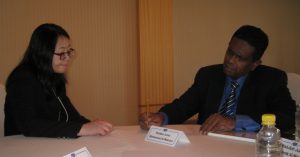 Some of the questions posed
Some of the questions posed
Questions for Jans Kim Mei Li on Compliance
- How does Maybank monitor/supervise the Group Compliance Functions?
- What are the reporting/organization structures of Compliance Division at Maybank?
- Does the Compliance Division carry out compliance audits/checks at the branch network? If so, what are the areas covered under the check?
- Are new employees screened at the time of recruitment from an AML/CFT perspective?
- Is the new product approval committee in function? And, is the procedure adopted by the committee?
- What is the procedure adopted by the Bank for screening of customers against sanction lists? What are the lists?
- What are the strategic committees appointed within the board?
- Who are treated as Key Management Persons (KMPs) in the bank?
- Procedure adopted by Maybank in complying with FATCA regulations?
- Ways of identifying US citizens from the existing customer data base?
- How to identify and report recalcitrant customers?
- How to withhold US source payments against the bank’s secrecy laws of the country?
- What is the procedure adopted in identification and categorization of politically exposed persons (PEPs)?
- What are the board approved policies in relation to compliance? (Eg: AML/KYC, Risk management, Operational Risk, Compliance, PEP, etc.)
- Is the bank under a deposit insurance scheme? If so, what are the limits?
- How does the Bank implement a risk based compliance function? What are the tools used and how does it rank the operations form a risk perspective?
- What is the bank’s approach towards legacy accounts? How does it address accounts without KYC?
- What is your procedure to risk rate a customer? How frequently does the bank take KYC from customers?
- What is the methodology of identifying suspicious transactions and its practical approach? How frequently does Maybank review the rules?
- With the rising demand on Compliance in today’s banking industry, having presence in not only Asia but also New York and London, what is Maybank’s strategy to protect the organisation?
- To what extent does Maybank observe US, EU and UN sanction lists?
- Does Central Bank of Malaysia have sanction list?
Questions for Loo Eng Hock on Client experience from a transaction banking perspective
- Does Maybank have relending facility program?
- What is Maybank’s market share currently in Transaction Banking perspective?
- How does Maybank position the organisation to compete with other banks in Malaysia?
Questions for Lim Siow Yee on Maybank’s international journey, mission and aspirations
- Does Maybank have any further expansion plan in Asia? If yes, where are the next most probable places?
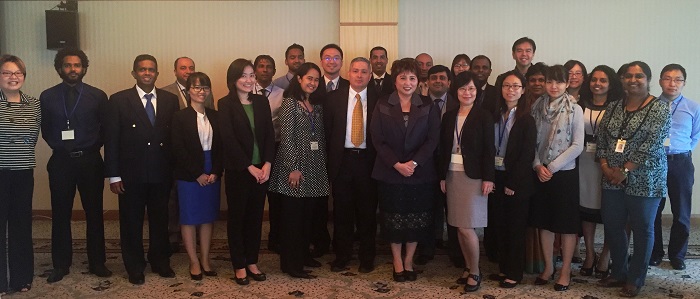

Leave a Reply